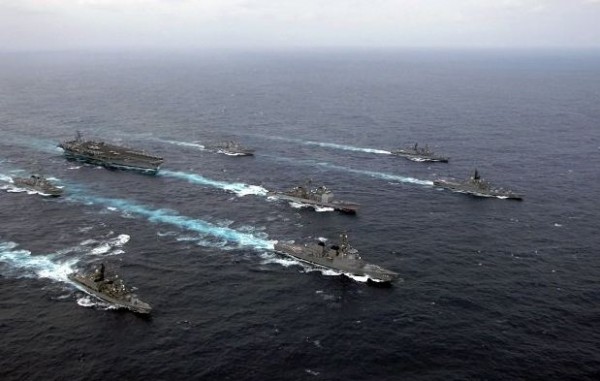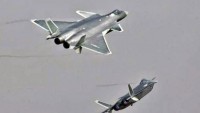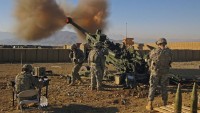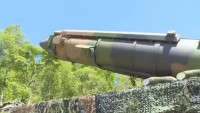US, UK, Japan Forming Anti-China Military Alliance in Asia
| Arthur Dominic Villasanta | | Jan 09, 2017 06:33 AM EST |
(Photo : US Navy) USS Ronald Reagan Carrier Strike Group.
The unexpected announcement by the United Kingdom in December 2016 it plans to have a new aircraft carrier and aircraft of its Royal Navy begin patrols of the South China Sea in 2021 went unnoticed as a triumph of American diplomacy.
The United States finally convinced the wavering British into joining them and Japan as the frontline states prepared to use military force to prevent China from taking military control over the South China Sea.
Like Us on Facebook
It is now also clear it would be advantageous for the U.S./UK/Japan alliance to quickly seek a military solution to this standoff with a series of sea battles that exploit the serious weaknesses in the People's Liberation Army Navy (PLAN).
PLAN is outnumbered in numbers of modern warships; in numbers of modern military aircraft and is technologically inferior to the alliance. This war will be a sea war where China will seek to fight within 1,000 kilometers of its coastline to allow its anti-ship ballistic missiles to enter the fight, while PLAN shies away from confronting a quantitatively and qualitatively superior enemy.
China has no allies in this fight. China will fight alone.
China is unloved and disrespected on a world stage dominated by liberal democracies that will tolerate, but not accept, despotic states like China.
China will lose everything it has gambled to gain in the coming war: military dominance over its backyard ocean; the status as Asian hegemon it has long coveted and, ultimately, the country that will replace the United States as the mightiest military state on Earth.
For the allies, a coming war will almost certainly be the short, sharp and victorious war their planning envisions, not the least because of the crippling deficiencies plaguing PLAN, which has only one operational training aircraft carrier (the CNS Liaoning) with only 25 Shenyang J-15 jets as its offensive weapons.
The U.S. Navy currently has three Nimitz-class aircraft carriers and their associated carrier air groups rotating in and out of the South China Sea and the Pacific Ocean. To this formidable array will be added the HMS Queen Elizabeth II, the Royal Navy's newest carrier comparable to the Nimitz-class and far superior to the Liaoning.
And then there's the Japan Maritime Self-Defense Force (JMSDF), whose backbone are Japanese-made and American-made guided missile destroyers and their missile systems designed to destroy attacks by manned aircraft, missiles and drones at long range.
In October 2016, Dennis C. Blair, who was the United States' Director of National Intelligence from 2009 to 2010, said the U.S. and China are locked into opposing positions that make it almost impossible to reach a compromise.
Blair pointed out China's claim to own the South China Sea despite a ruling by the Permanent Court of Arbitration to the contrary is "intolerable" for the U.S. This impasse has created a situation where neither side can be seen to be backing down. And this might trigger a war.
The prevailing situation could "lead to conflict. Misunderstanding, then fear and conflict."
Blair is also a retired U.S. Navy Admiral who was formerly Commander, United States Pacific Command (USPACOM) from 1999 to 2002, and has the experience and expertise to analyze the military situation in the South China Sea.
USPACOM is responsible for U.S. Navy operations in the Indo-Asia-Pacific region in the event of war. It commands the United States Seventh Fleet, the largest of the forward-deployed U.S. fleets, with 60 to 70 ships, 300 aircraft and 40,000 Navy and Marine Corps personnel.
Blair is confident the U.S. will quickly and easily defeat China in any conflict.
His optimism might be anchored on the realities the U.S. Navy can bring to bear enormous firepower against any fleet of the three fleets of the People's Liberation Army Navy (PLAN), which operates no combat-capable carrier. PLAN has classified its only carrier, the Liaoning, a training carrier unsuitable for combat.
China's much advertised DF-21D anti ship ballistic missile is also under development and its immature kill chain might prevent it from even acquiring fast moving U.S. Navy carrier strike groups hundreds of kilometers distant. Chinese submarines, while a threat, aren't a serious enough threat to curtail operations of U.S. Navy ships.
But if a conflict were to occur, this will likely be triggered by China.
If there should be war, Blair is confident the U.S. Navy and the U.S. Air Force are capable of rapidly "neutralizing" China's outposts in the South China Sea, which are practically defenseless from a determined attack being isolated and strung out over hundreds of kilometers of sea.
These offensive operations by the Navy and Air Force will only take "probably 10 or 15 minutes' worth of worth of work for U.S. forces."
U.S. Navy Admiral Harry Harris, Jr., Commander, United States Pacific Command (CDRUSPACOM), in December said the United States stands ready for a military confrontation against China should the latter insist on enforcing its patently unlawful claims to own most of the South China Sea.
He noted that China continues to act in an "aggressive" manner in the South China Sea, to which the United States stands ready to respond.
"We will not allow a shared domain to be closed down unilaterally no matter how many bases are built on artificial features in the South China Sea," said Admiral Harris.
"We will cooperate when we can but we will be ready to confront when we must."
TagsUnited Kingdom, United States, Japan, china, South China Sea, People's Liberation Army Navy
©2015 Chinatopix All rights reserved. Do not reproduce without permission
EDITOR'S PICKS
-

Did the Trump administration just announce plans for a trade war with ‘hostile’ China and Russia?
-

US Senate passes Taiwan travel bill slammed by China
-

As Yan Sihong’s family grieves, here are other Chinese students who went missing abroad. Some have never been found
-

Beijing blasts Western critics who ‘smear China’ with the term sharp power
-

China Envoy Seeks to Defuse Tensions With U.S. as a Trade War Brews
-

Singapore's Deputy PM Provides Bitcoin Vote of Confidence Amid China's Blanket Bans
-

China warns investors over risks in overseas virtual currency trading
-

Chinese government most trustworthy: survey
-

Kashima Antlers On Course For Back-To-Back Titles
MOST POPULAR
LATEST NEWS
Zhou Yongkang: China's Former Security Chief Sentenced to Life in Prison

China's former Chief of the Ministry of Public Security, Zhou Yongkang, has been given a life sentence after he was found guilty of abusing his office, bribery and deliberately ... Full Article
TRENDING STORY

China Pork Prices Expected to Stabilize As The Supplies Recover

Elephone P9000 Smartphone is now on Sale on Amazon India

There's a Big Chance Cliffhangers Won't Still Be Resolved When Grey's Anatomy Season 13 Returns

Supreme Court Ruled on Samsung vs Apple Dispute for Patent Infringement

Microsoft Surface Pro 5 Rumors and Release Date: What is the Latest?














